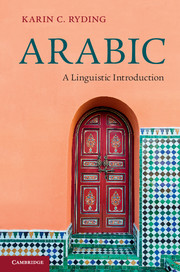Book contents
- Frontmatter
- Contents
- List of figures
- Preface
- Acknowledgments
- Abbreviations and symbols used in this book
- 1 Arabic linguistics: overview and history
- 2 Arabic phonology
- 3 Arabic phonotactics and morphophonology
- 4 Arabic syllable structure and stress
- 5 Introduction to Arabic morphology
- 6 Derivational morphology: the root/pattern system
- 7 Non-root/pattern morphology and the Arabic lexicon
- 8 Arabic inflectional morphology
- 9 Syntactic analysis and Arabic
- 10 Arabic syntax I: phrase structure
- 11 Arabic syntax II: clause structure
- Appendix A Fields of linguistics and Arabic
- Appendix B Arabic transcription/transliteration/romanization
- Appendix C Arabic nominal declensions
- Glossary of technical linguistic terms
- References
- Index
- References
7 - Non-root/pattern morphology and the Arabic lexicon
Published online by Cambridge University Press: 05 June 2014
- Frontmatter
- Contents
- List of figures
- Preface
- Acknowledgments
- Abbreviations and symbols used in this book
- 1 Arabic linguistics: overview and history
- 2 Arabic phonology
- 3 Arabic phonotactics and morphophonology
- 4 Arabic syllable structure and stress
- 5 Introduction to Arabic morphology
- 6 Derivational morphology: the root/pattern system
- 7 Non-root/pattern morphology and the Arabic lexicon
- 8 Arabic inflectional morphology
- 9 Syntactic analysis and Arabic
- 10 Arabic syntax I: phrase structure
- 11 Arabic syntax II: clause structure
- Appendix A Fields of linguistics and Arabic
- Appendix B Arabic transcription/transliteration/romanization
- Appendix C Arabic nominal declensions
- Glossary of technical linguistic terms
- References
- Index
- References
Summary
The Arabic lexicon
The Arabic lexicon, the word-stock of the language, consists primarily of words derived through the dominant paronymic root/pattern system of derivational morphology. However, a substantial segment of the lexicon consists of non-root/pattern-based lexemes. These items include solid stems that date back to the earliest forms of Arabic (such as laa ‘no,’ or hum ‘they m.’), borrowed foreign words and expressions, and the results of non-root/pattern processes such as suffixation and compounding for word-creation and lexical expansion. This chapter examines both solid stems and the processes for expansion of the lexicon which supplement the richness of root/pattern Arabic morphology.
Solid stems
Solid stems are words which cannot be reduced morphologically or analyzed in the typical root-and-pattern system. They consist of primarily four sets in Arabic: function words, pronouns, adverbs, and loanwords. Unlike words based on lexical roots, solid-stem words are normally listed according to their orthography in Arabic dictionaries.
- Type
- Chapter
- Information
- ArabicA Linguistic Introduction, pp. 79 - 88Publisher: Cambridge University PressPrint publication year: 2014



